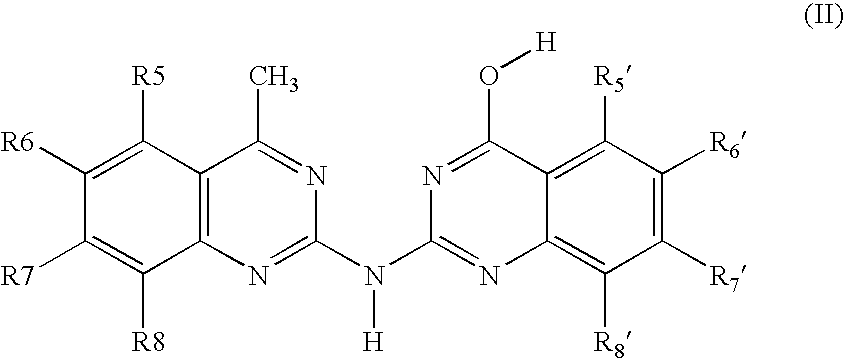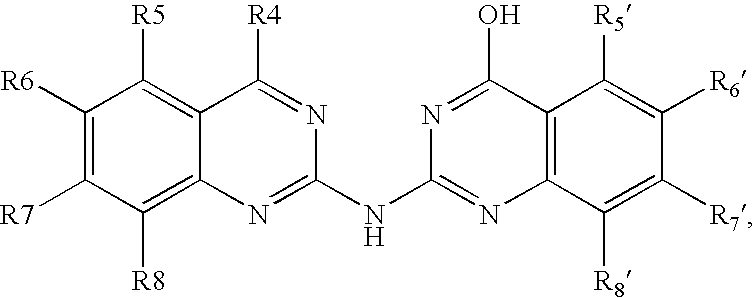Bis-quinazoline compounds for the treatment of bacterial infections
a technology of bisquinazoline and compounds, applied in the field of bisquinazoline compounds for the treatment of bacterial infections, can solve problems such as trigger cell death
- Summary
- Abstract
- Description
- Claims
- Application Information
AI Technical Summary
Benefits of technology
Problems solved by technology
Method used
Image
Examples
example 1
General Method A for the Preparation of Bis-Quinazolines
[0229]
[0230] The hydrochloride salt of aniline of formula 1 is suspended in anhydrous solvent such as tetrahydrofuran and sodium dicyanamide is added. The mixture is stirred at between 20-70° C., preferred at 40° C. overnight, and subsequently filtered and washed with a solvent such as THF. The product 2 is dried under vacuum. The obtained product is suspended in an anhydrous solvent such as THF and alkyl anthranilate of formula 3 and concentrated acid such as hydrochloric. The mixture is stirred at between 20-80° C., preferably 60° C. overnight under nitrogen flow. The solid material obtained is purified by silica gel chromatography using combination of solvents such as dichloromethane, methanol and triethylamine, preferably dichloromethane, methanol and triethylamine.
example 2
General Method B for the Preparation of Bis-Quinazolines
[0231]
[0232] In method B, quinazolin-2-yl guanidine of formula 5 is dissolved in anhydrous solvents such as dimethylformamide, isatoic anhydride of formula 6 and tertiary amine such as diisopropylethylamine are added. The mixture is stirred at between 20-130° C., preferably at 100° C. overnight. The reaction is cooled to 0-30° C., preferably to room temperature and the product 7 is filtered and washed with a small amount of solvents such as dimethylformamide, tetrahydrofuran, and diethyl ether and dried.
example 3
General Method C for the Preparation of Bis-Quinazolines
[0233]
[0234] Into a sealable microwave vessel is placed a Teflon® stirbar, Bis-quinazolin-2-yl-amines of formula 8 and anhydrous solvents such as NMP. To this stirring suspension is added nucleophile such as amine, metal hydroxide or metal alkoxide. The vessel is sealed and heated at between 100-200° C., 300 W, for 1-120 minutes, preferably 150° C. for 30 minutes in the Emrys™ Optimizer, microwave synthesizer, by Personal Chemistry®. The resultant solution is precipitated into solvents such as diethyl ether. The solid material obtained is purified by silica gel chromatography using combination of solvents such as dichrolomethane, methanol with ammonia or tertiary amine such as triethylamine, preferably triethyl amine. The product is converted to a suitable pharmaceutically acceptable salt form by mixing the product solution in organic solvents with acid such as trifluoroacetic acid or hydrochloric acid and evaporating the vola...
PUM
| Property | Measurement | Unit |
|---|---|---|
| weight | aaaaa | aaaaa |
| temperature | aaaaa | aaaaa |
| volume | aaaaa | aaaaa |
Abstract
Description
Claims
Application Information
 Login to View More
Login to View More - R&D
- Intellectual Property
- Life Sciences
- Materials
- Tech Scout
- Unparalleled Data Quality
- Higher Quality Content
- 60% Fewer Hallucinations
Browse by: Latest US Patents, China's latest patents, Technical Efficacy Thesaurus, Application Domain, Technology Topic, Popular Technical Reports.
© 2025 PatSnap. All rights reserved.Legal|Privacy policy|Modern Slavery Act Transparency Statement|Sitemap|About US| Contact US: help@patsnap.com



